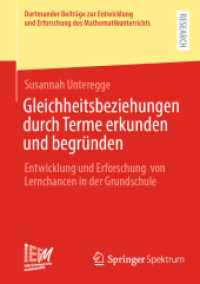- ホーム
- > 洋書
- > ドイツ書
- > Humanities, Arts & Music
- > History
- > miscellaneous
Description
(Text)
The current volume developed out of an international workshop of the German Research Foundation's Research Group 530 on "self-narratives in a transcultural perspective" [DFG-Forschergruppe 530 "Selbstzeugnisse in transkultureller Per-spektive"] that was held at the Orient-Institut Istanbul from September 29 until October 2, 2009. The workshop formed part of a long-standing cooperation with the Orient-Institut Istanbul, where research on transcultural self-narratives con-tinues beyond the term of the research group, with the project "Istanbul Memo-ries. Personal narratives of the late Ottoman period" (www.istanbulmemories.org). The stimulating discussions at the Orient-Institut Istanbul centered around the multifaceted interplay between dress and person/personhood in written self-narratives or ego documents. By focusing on "Fashioning the Self in Transcul-tural Settings: The Uses and Significance of Dress in Self-Narratives," we hoped to supplement the existing research on self-narratives with the dimension of ma-terial culture. In the workshop light was shed on the potential of dress to shape identities, to express forms of affiliation or foreignness, as well as on vestimen-tary practices. Were clothes simply purchased to be worn, to possess, and to give away as a gift or in barter trade? During the presentations and discussions it be-came clear that new insights might be gleaned if one widens the focus in self-narratives, beyond material culture to include the consideration of other sources such as trousseau inventories or account books.








